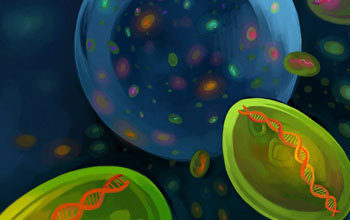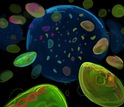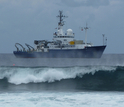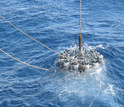News Release 14-059
Octillions of microbes in the seas: Ocean microbes show incredible genetic diversity
In a few drops of seawater, one species, hundreds of subpopulations

Artist's interpretation of Prochlorococcus diversity in a drop of seawater.
April 24, 2014
This material is available primarily for archival purposes. Telephone numbers or other contact information may be out of date; please see current contact information at media contacts.
The smallest, most abundant marine microbe, Prochlorococcus, is a photosynthetic bacterial species essential to the marine ecosystem.
It's estimated that billions of the single-celled creatures live in the oceans, forming the center of the marine food web.
They occupy a range of ecological niches based on temperature, light, water chemistry and interactions with other species.
But the diversity within this single species remains a puzzle.
To probe this question, scientists at the Massachusetts Institute of Technology (MIT) recently performed a cell-by-cell genomic analysis of a wild population of Prochlorococcus living in a milliliter of ocean water--less than a quarter of a teaspoon--and found hundreds of distinct genetic subpopulations.
Each subpopulation in those few drops of water is characterized by a set of core gene alleles linked to a few associated flexible genes--a combination the scientists call the "genomic backbone."
This backbone gives the subpopulation a finely tuned ability to fill a particular ecological niche.
Diversity also exists within backbone subpopulations; most individual cells in the samples carried at least one set of flexible genes not found in any other cell in its subpopulation.
A report on the research by Sallie Chisholm and Nadav Kashtan at MIT, along with co-authors, appears in this week's issue of the journal Science.
The National Science Foundation (NSF), through its Divisions of Environmental Biology and Ocean Sciences, supported the research.
"In this extraordinary finding on the power of natural selection, the scientists have discovered a mosaic of genetically distinct populations of one of the most abundant organisms on Earth," says George Gilchrist, program director in NSF's Division of Environmental Biology.
"In spite of the constant mixing of the oceans," Gilchrist says, "variations in light, temperature and chemistry create unique habitats that evolution has filled with an enormous diversity of populations over millions of years."
Adds David Garrison, program director in NSF's Division of Ocean Sciences, "The results will change the way marine ecologists think about how planktonic microbes and, in turn, planktonic communities may respond to climate and environmental change."
The scientists estimate that the subpopulations diverged at least a few million years ago.
The backbone is an older, more slowly evolving, component of the genome, while the flexible genes reside in areas of the genome where gene exchange is relatively frequent, facilitating more rapid evolution.
The study also revealed that the relative abundance of the backbone subpopulations changes with the seasons at the study site near Bermuda, adding strength to the argument that each subpopulation is finely tuned for optimal growth under different conditions.
"The sheer enormity of diversity that must be in the octillion Prochlorococcus cells living in the seas is daunting to consider," Chisholm says. "It creates a robust and stable population in the face of environmental instability."
Ocean turbulence also plays a role in the evolution and diversity of Prochlorococcus.
A fluid mechanics model predicts that in typical ocean flow, just-divided daughter cells drift rapidly, placing them centimeters apart from one another in minutes, tens of meters apart in an hour, and kilometers apart in a week's time.
"The interesting question is, 'Why does such a diverse set of subpopulations exist?'" Kashtan says.
"The huge population size of Prochlorococcus suggests that this remarkable diversity and the way it is organized is not random, but is a masterpiece product of natural selection."
Chisholm and Kashtan say the evolutionary and ecological distinction among the subpopulations is probably common in other wild, free-living (not attached to particles or other organisms) bacteria species with large populations and highly mixed habitats.
Other co-authors of the paper are Sara Roggensack, Sébastien Rodrigue, Jessie Thompson, Steven Biller, Allison Coe, Huiming Ding, Roman Stocker and Michael Follows of MIT; Pekka Marttinen of the Helsinki Institute for Information Technology; Rex Malmstrom of the U.S. Department of Energy Joint Genome Institute and Ramunas Stepanauskas of the Bigelow Laboratory for Ocean Sciences.
The NSF Center for Microbial Oceanography, U.S. Department of Energy Genomics Science Program and the Gordon and Betty Moore Foundation Marine Microbiology Initiative also supported the work.
-NSF-
-
Prochlorococcus in freeform, an artist's rendering of microbes in the ocean.
Credit and Larger Version -
Marine ecologists take to the high seas to collect water samples loaded with ocean microbes.
Credit and Larger Version -
Preparing to retrieve samples of ocean water for shipboard and later shore-based analysis.
Credit and Larger Version -
Down to the deep blue sea: Instruments descend into ocean waters.
Credit and Larger Version -
Scanning electron micrograph of the marine microbe Prochlorococcus.
Credit and Larger Version
Media Contacts
Cheryl Dybas, NSF, (703) 292-7734, email: cdybas@nsf.gov
Denise Brehm, MIT, (617) 253-8069, email: brehm@mit.edu
Related Websites
NSF Center for Microbial Oceanography (C-MORE): http://cmore.soest.hawaii.edu/
NSF Discovery: Queen of Spades Key to New Evolutionary Hypothesis: http://www.nsf.gov/discoveries/disc_summ.jsp?cntn_id=124158&org=OLPA
NSF News: Scientists Discover Interplay Between Genes and Viruses in Tiny Ocean Plankton: http://www.nsf.gov/news/news_summ.jsp?cntn_id=106794&org=NSF&from=news
The U.S. National Science Foundation propels the nation forward by advancing fundamental research in all fields of science and engineering. NSF supports research and people by providing facilities, instruments and funding to support their ingenuity and sustain the U.S. as a global leader in research and innovation. With a fiscal year 2023 budget of $9.5 billion, NSF funds reach all 50 states through grants to nearly 2,000 colleges, universities and institutions. Each year, NSF receives more than 40,000 competitive proposals and makes about 11,000 new awards. Those awards include support for cooperative research with industry, Arctic and Antarctic research and operations, and U.S. participation in international scientific efforts.
Connect with us online
NSF website: nsf.gov
NSF News: nsf.gov/news
For News Media: nsf.gov/news/newsroom
Statistics: nsf.gov/statistics/
Awards database: nsf.gov/awardsearch/
Follow us on social
Twitter: twitter.com/NSF
Facebook: facebook.com/US.NSF
Instagram: instagram.com/nsfgov





